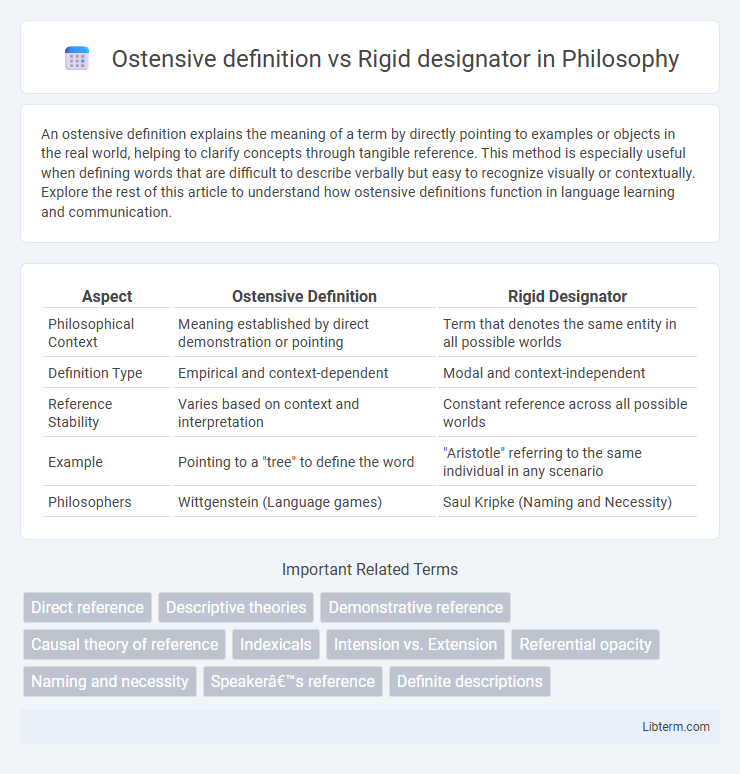An ostensive definition explains the meaning of a term by directly pointing to examples or objects in the real world, helping to clarify concepts through tangible reference. This method is especially useful when defining words that are difficult to describe verbally but easy to recognize visually or contextually. Explore the rest of this article to understand how ostensive definitions function in language learning and communication.
Table of Comparison
| Aspect | Ostensive Definition | Rigid Designator |
|---|---|---|
| Philosophical Context | Meaning established by direct demonstration or pointing | Term that denotes the same entity in all possible worlds |
| Definition Type | Empirical and context-dependent | Modal and context-independent |
| Reference Stability | Varies based on context and interpretation | Constant reference across all possible worlds |
| Example | Pointing to a "tree" to define the word | "Aristotle" referring to the same individual in any scenario |
| Philosophers | Wittgenstein (Language games) | Saul Kripke (Naming and Necessity) |
Introduction to Ostensive Definitions and Rigid Designators
Ostensive definitions clarify meaning by directly pointing to an object or example, facilitating understanding through sensory experience and immediate reference. Rigid designators, a concept from modal logic and introduced by Saul Kripke, refer to the same entity in every possible world, ensuring strict identity regardless of context or circumstances. Both serve crucial roles in semantics, with ostensive definitions anchoring language in observable reality and rigid designators maintaining consistent reference across hypothetical scenarios.
Understanding Ostensive Definitions: Meaning Through Examples
Ostensive definitions clarify meaning by directly pointing to examples, enabling learners to grasp a concept through concrete instances rather than abstract descriptions. Unlike rigid designators, which denote a specific, unchanging reference across possible worlds, ostensive definitions rely on context-dependent demonstrations to convey meaning. This method proves especially effective in language acquisition and philosophy by grounding terms in observable reality.
Key Features of Rigid Designators in Philosophy
Rigid designators are terms in philosophy that refer to the same object in every possible world where that object exists, maintaining consistent reference across all contexts. Key features include their necessity in identifying entities without variation and their role in modal logic to distinguish between contingent and necessary truths. Unlike ostensive definitions that rely on direct pointing or examples, rigid designators function through fixed semantic reference, crucial in discussions of meaning and identity.
Historical Background: Kripke and the Theory of Reference
Saul Kripke revolutionized the theory of reference in the 1970s by introducing the concept of rigid designators, terms that refer to the same object in all possible worlds. His work challenged descriptivist theories of meaning, contrasting with ostensive definitions that rely on direct pointing or demonstration for meaning. Kripke's modal logic framework emphasized necessity and identity, fundamentally reshaping semantics and the philosophy of language.
Comparative Analysis: Ostensive Definition vs Rigid Designator
Ostensive definition involves clarifying meaning by directly pointing to examples or instances, facilitating language learning through observable demonstrations. Rigid designators, a concept in modal logic and philosophy of language, refer to terms that designate the same object in all possible worlds where that object exists, ensuring referential stability. Comparative analysis highlights that ostensive definitions rely on empirical context for meaning, while rigid designators are grounded in metaphysical necessity, emphasizing their differing roles in semantics and reference theory.
Contexts of Use: Everyday Language and Formal Logic
Ostensive definitions clarify meaning in everyday language by pointing to examples or instances, grounding abstract terms through direct sensory experience, which aids in basic communication and conceptual understanding. Rigid designators, a concept in formal logic and philosophy of language, refer to terms that denote the same object across all possible worlds, ensuring consistency in modal contexts and precise reference in logical analysis. The key distinction lies in their application: ostensive definitions rely on contextual demonstration and pragmatic use, while rigid designators require strict semantic stability across hypothetical scenarios for analytical rigor.
Philosophical Implications of Rigid Designation
Ostensive definition involves explaining a term by directly pointing to an example, which often relies on context and perception, making its reference somewhat flexible. Rigid designation, introduced by Saul Kripke, refers to terms that designate the same object in all possible worlds where that object exists, highlighting necessity in identity and reference. Philosophically, rigid designation impacts modal logic and metaphysics by challenging descriptivist theories of reference and emphasizing the necessity of certain truths about identity across possible worlds.
The Role of Ostensive Definitions in Language Acquisition
Ostensive definitions play a crucial role in language acquisition by directly linking words to sensory experiences, enabling learners to grasp meanings through pointed examples or demonstrations. Unlike rigid designators, which consistently refer to the same entity across all possible worlds, ostensive definitions ground language learning in immediate context, facilitating the association between linguistic expressions and perceptual stimuli. This dynamic approach supports rapid vocabulary expansion in early childhood by providing clear, demonstrable referents for new terms.
Criticisms and Limitations of Both Concepts
Ostensive definition faces criticism for its reliance on context and potential ambiguity, as it often presupposes shared understanding of the referent, limiting clarity in complex or abstract concepts. Rigid designators encounter limitations in handling modal variations and referential opacity, as their strict reference across possible worlds can oversimplify the fluidity of meaning in natural language. Both concepts struggle to accommodate semantic flexibility, leading to ongoing debates about their effectiveness in capturing the nuances of linguistic reference and meaning.
Conclusion: Bridging Meaning and Reference in Semantics
Ostensive definitions establish meaning by direct demonstration, grounding language in tangible examples, whereas rigid designators maintain consistent reference across possible worlds, anchoring semantics in identity and necessity. Bridging meaning and reference requires understanding how ostension clarifies conceptual content while rigidity ensures stable reference, creating a comprehensive framework for semantic interpretation. This synthesis enhances linguistic analysis by integrating how words acquire and preserve meaning through context and necessity.
Ostensive definition Infographic

 libterm.com
libterm.com